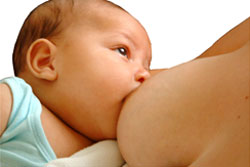- Breast milk production
- The uniqueness of human breast milk
- The do’s and don’ts of breastfeeding
- Common breastfeeding problems
- Sore and cracked nipples
- Breast engorgement
- Plugged milk ducts
- Mastitis
- Thrush (yeast infection)
- Malfunctioning of the let-down reflex and breast milk supply
- Inverted and flat nipples
- Risk of transmission of HIV through breastfeeding
- First lesson at breastfeeding
- Key messages
Breast milk production
Virtual Medical Centre Video

The establishment and maintenance of breastfeeding is important for the healthy growth and development of the new born baby and also offers some health benefits for the mother.

The uniqueness of human breast milk
Human milk has no substitute and is incomparable to any formula milk preparations. The breast is nature’s apparatus for feeding babies; any other perceived purpose for the breast is but secondary. The reasons why you should put away formula milk and breastfeed your baby exclusively for six months include the following:
- The first yellowish breast milk called colostrum is particularly rich in nutrients including vitamins A & K, zinc and essential fatty and amino acids that are necessary for brain development. Colostrum is also rich in antibodies that helps protect the child against infections. Formula milk lacks the immune factors that breast milk contains.
- Breast milk contains all the necessary nutrients in their right proportions that can sustain your baby for the next six months of life.
- Breast milk contains essential amino and fatty acids which cannot be received from any animal milk. These essential fatty and amino acids are important for brain development.
- Skin-to-skin contact between mother and baby during breastfeeding establishes strong love and bonding between the two.
- Breast milk is always at the right temperature and can be served any time; no need for preparation.
- More economical than formula milk.
- The act of breastfeeding promotes jaw and oral cavity development.
- Formula feeding is associated with increased risk of pulmonary heart disease and juvenile Diabetes Mellitus in the future.
- Breastfeeding helps you return to your pre-pregnancy state because you lose weight as you breastfeed.
- Early initiation of breastfeeding is associated with uterine contraction and thereby reduces postpartum blood loss.
- Protects against risks of breast and ovarian cancer.
- Delays return to menstruation.
- Serves as a family planning method because as breastfeeding has contraceptive effect (that is, the lactational amenorrhoea method).
The do’s and don’ts of breastfeeding
Initiate breastfeeding within 30-60 minutes after delivery and feed your baby the yellowish breast milk. Colostrum serves as the first immunization for your child. The suckling reflex is greatest within 20-30 minutes after delivery and that is the right time to introduce your child to breastfeeding.
- Properly position and attach the baby to your breast. Proper attachment is a skill that must be learnt and it is essential for a successful breastfeeding.
- Breastfeed on demand and not follow scheduled time-table feeding: the more the child suckles, the more the breast milk will flow.
- Empty one breast at a time (that is, allow the child to completely empty one breast before offering the other). This will ensure that both the fore-milk (mainly water) and hind-milk (mainly fat and other nutrients) is consumed.
- Practice night breastfeeding because the hormone responsible for breast milk production (prolactin) is secreted in more sufficient quantities in the night than during the day.
- Exclusively breastfeed for the first six months of life and continue breastfeeding for at least two years. Exclusive breastfeeding means the baby is fed only breast milk for the first six months of life without giving anything, not even water.
- You can take a mild pain reliever such as Tylenol or Advil about 30 minutes prior to nursing or around the clock until your discomfort lessens or disappears. Both of these drugs are compatible with breastfeeding.
- If you are sick from a cold or the flu, you can continue breastfeeding. Your baby will benefit from the antibodies in your milk.
- Avoid giving prelacteals (that is, water, glucose water, honey, artificial milk). Prelacteals will prevent your child from suckling and thus miss the vital colostrum. They are also sources of contamination.
- Do not take the child off the breast; allow the child to stop breastfeeding. Sudden removal of the breast from the child’s mouth can cause sore nipples.
- You may consider joining the Australian Breastfeeding Association to benefit from counselling services.
Common breastfeeding problems
Though breastfeeding (nursing) can be pleasurable experience, some breastfeeding related problems can occur especially during the first weeks of nursing if improper breastfeeding techniques are adopted. The following are common breastfeeding problems that can easily be managed.
Sore and cracked nipples
Most new breastfeeding women experience sore nipples. The signs of nipple soreness include itchy, red and painful nipple. Nipple soreness may result from one or more of the following:
- Improper attachment of the baby to the breast. If the baby takes on only the nipple area during breastfeeding, sore nipples will result.
- Improper positioning of the baby during breastfeeding
- Excessive dry or moist skin can also cause nipple soreness. If you wear ill-fitting bras especially those made from synthetic fabrics, evaporation from the breast area will be limited, thereby resulting in accumulation of moisture.
- Some soaps or solutions that remove natural skin oils can also cause excessively dry skin.
- Abrupt removal of the breast from the child’s mouth (that is, incomplete suction release at the end of a feeding).
- Nipple soreness may be caused by incomplete suction release at the end of your baby’s feeding. The baby chewing or biting on the nipples at the time the teething. The baby will bite in order to relieve himself of itching of the gums.
The following will help manage sore or cracked nipples: Ensure that the baby is latched on properly, that is, a greater part of the areola (dark portion) of the breast enters the child’s mouth. The baby should also be directly facing the breast, not pulling it away from your body. To get this right, make sure child opens the mouth widely before you put in the breast making sure that your baby’s mouth is over the areola and not just the nipple. With proper attachment, sore nipples will be avoided.
- Additionally, avoid washing the breast with soap as that has drying effect on the breast and can thus increase pain. Instead use ordinary water in cleaning your breast.
- If you experience inflammation or cracked nipple, application of some creams containing lanolin may be helpful, for example, Pure LAN 100 Nipple Cream, and Belli Cosmetics Pure Comfort Nursing Cream. Vaseline and olive oil are also effective in the management of sore or cracked nipples.
- Application of expressed breast milk on cracked nipples and allow it to air dry is another recommended way of managing sore and cracked nipples.
- You can stop the child from breastfeeding by gently inserting a finger into the side of the mouth to break the suction.
Breast engorgement
Breast engorgement may occur because the breasts are not emptied resulting in an accumulation of breast milk. The breasts are usually swollen, hard, and painful. Breastfeeding is difficult because the nipples cannot protrude to allow the baby to latch on correctly. The underlying cause is the congestion of the blood vessels in the breast. To manage this problem, you need to:
- Breastfeed frequently and also express the breast milk mechanically or by use of suction pump to promote milk flow.
- You can also apply cold packs on the breasts, together with clean cabbage leaves for about 20 minutes to stimulate milk ejection and reduce swelling of the breast. The cold will feel good and decrease the swelling.
- An engorged breast may flatten your nipple, making it more difficult for your baby to latch-on. Use hand expression of milk to soften the areola just before latch-on.
- Feed your baby on demand, approximately every one to three hours for at least 15 minutes of suckling on each breast. Do not skip feedings.
- Wear a supportive bra and get in a comfortable and supported position for feedings.
Plugged milk ducts
The milk ducts can become plugged if the breast is not emptied frequently. Symptoms of a plugged milk duct include tenderness, heat and redness in one area of the breast, or a palpable lump close to the skin. The solution lies with the application of dry or moist heat compresses to the breast for ten minutes, three times daily. You can also massage your breast with warm water.
Mastitis
Mastitis is an inflammation of the breast that can be caused by an infection, some type of obstruction, or an allergy. The symptoms include painful swelling, fever, and aching muscles. If you have mastitis it is still safe to breastfeed and frequent suckling will promote quick healing. Breast infection is common among women who are stressed, have cracked nipples, plugged milk ducts or breast engorgement, or wear a tight bra. Mastitis is treated with antibiotics. Application of moist, warm compresses to the infected part, having enough rest and wearing comfortable bra are other options for the treatment of breast infection.
Thrush (yeast infection)
Thrush is caused by yeast. Breastfeeding mothers are at risk for developing thrush if they have taken or are currently taking antibiotics. Cracked nipples from poor positioning can also be a cause for thrush. This is a lesser breast feeding problem. The signs of yeast infection of the breast include itchy red or pink and shiny nipples that feel uncomfortable during breastfeeding. If you experience yeast infection, consult your doctor. However, you can still continue to breastfeed. The mother’s diet during thrush should show a reduction of sugar and no artificial sweeteners. You can have some fruits and natural fruit juices, but they will best be consumed with other non-sweet foods. Herbal teas and water are a good choice of drink. Eliminate dairy products until two weeks after all symptoms are gone.
Malfunctioning of the let-down reflex and breast milk supply
The two important hormones that control milk production are prolactin and oxytocin. The let-down reflex is controlled by oxytocin. Pain, stress, and anxiety can interfere with this reflex. Emotional distress in mothers can therefore cause the retention of milk within the milk glands because the let-down-reflex is not functioning properly. The frequency of feedings also contributes to the production of milk. Treatment includes relaxation and a comfortable nursing position. Reducing distractions during nursing, performing a gentle massage, and applying heat to the breast will also help. What really a matter is that you are happy and healthy, as well as the baby.If the problem persists, consult your doctor.
Inverted and flat nipples
Women with either inverted or flat nipples may find it difficult to breastfeed. Wearing of special nipple cups called breast shells between feedings may help draw their nipple out. After you have delivered, hand expression or pumping may help extrude the nipple. However, you should not twist or pull on your nipple as that may cause nipple trauma.
Risk of transmission of HIV through breastfeeding

First lesson at breastfeeding
Breastfeeding is an art that new breastfeeding mothers have to learn. If you have never breastfed before, it is advisable to still feel confident that you can breastfeed your baby. Your first skill to be learnt is skin-to-skin contact between you and your baby in order to create some kind of bonding (that is, attraction). Feeling good in holding your baby close to you will facilitate the release the necessary hormones that assist breastfeeding. The first breast milk will be thicker than normal milk and this is yellowish in colour. As a ‘first timer’ you may not know whether your milk is flowing well. Some of the signs include the following:
- Your baby’s sucking rate will change from rapid sucks to sucking and swallowing rhythmically, at about one suck per second.
- You may feel within the breast a tingling or needle-like sensation.
- A sudden feeling of fullness in the breast.
- One breast may start to leak milk whilst the baby feeds on the other breast.
- You may become thirsty.
Key messages
Frequent suckling stimulates breast milk production.
- Remember to feed your child colostrum.
- Avoid all emotional problems, and anxiety.
- Almost every woman is capable of breastfeeding. So have the confidence that you can produce enough milk for your baby.
- Breast milk production is controlled by the hormones prolactin and oxytocin which are produced by a gland situated in your brain.
- Be careful with drugs as they can reach babies through breast milk.
- Equally, alcohol and smoking should be avoided since their effects can reach baby through breast milk and make baby feel sleepy, nervous and irritable.
- Join a baby friendly club for more support with breast feeding.
Please read Nutrition During Breastfeeding.
References
- Women and Newborn Health Service. Breastfeeding and breast care [online]. Subiaco, WA: King Edward Memorial Hospital; 2007 [cited 6 September 2007]. Available from: URL link
- Cravioto A, Tello A, Villafán H, et al. Inhibition of localized adhesion of enteropathogenic Escherichia coli to HEp-2 cells by immunoglobulin and oligosaccharide fractions of human colostrum and breast milk. J Infect Dis. 1991;163(6):1247-55. [Abstract]
- Bertotto A, Gerli R, Fabietti G, et al. Human breast milk T lymphocytes display the phenotype and functional characteristics of memory T cells. Eur J Immunol. 1990;20(8):1877-80. [Abstract]
- Van Biervliet JP, Vinaimont N, Vercaemst R, Rosseneu M. Serum cholesterol, cholesteryl ester, and high-density lipoprotein development in newborn infants: Response to formulas supplemented with cholesterol and gamma-linolenic acid. J Pediatr. 1992;120(4 Pt 2):S101-8. [Abstract]
- Resolution WHA47.5: Infant and young child nutrition [online]. Forty-Seventh World Health Assembly; 9 May 1994 [cited 6 September 2007]. Available from: URL link
- Infant and young child nutrition: Quadrenniel report [online]. Fifty-Ninth World Health Assembly; 4 May 2006 [cited 6 September 2007]. Available from: URL link
- International code of marketing of breast milk substitutes [online]. Geneva: World Health Organization; 1981 [cited 6 September 2007]. Available from: URL link
- Coutsoudis A. Current status of HIV and breastfeeding research. Breastfeeding Abstracts. 2005;24(2):11-2. [Full text]
- Coutsoudis A, Dabis F, Fawzi W, et al. Late postnatal transmission of HIV-1 in breast-fed children: An individual patient data meta-analysis. J Infect Dis. 2004;189(12):2154-66. [Abstract | Full text]
- Coutsoudis A, Pillay K, Kuhn L, et al. Method of feeding and transmission of HIV-1 from mothers to children by 15 months of age: Prospective cohort study from Durban, South Africa. AIDS. 2001;15(3):379-87. [Abstract]
- Leroy V, Becquet R, Rouet F, et al. Postnatal transmission risk according to feeding modalities in children born to HIV-infected mothers in a PMTCT project in Abidjan, Cote d’Ivoire. Abstract MoPpB2007. Presented at the International AIDS Conference, Bangkok; 2004. [Abstract]
- Piwoz E, Iliff T, Tavengwa N, et al. Early introduction of non-human milk and solid foods increases the risk of postnatal HIV-1 transmission in Zimbabwe. Abstract MoPpB2008. Presented at the International AIDS Conference, Bangkok; 2004. [Abstract]
- Hawthorne K. Intention and reality in infant feeding. Mod Midwife. 1994;4(3):25-8. [Abstract]
- Gross SM, Caulfield LE, Bentley ME, et al. Counseling and motivational videotapes increase duration of breast-feeding in African-American WIC participants who initiate breast-feeding. J Am Diet Assoc. 1998;98(2):143-8. [Abstract]
- Dermer A. Overcoming medical and social barriers to breastfeeding. Am Fam Physician. 1995;51(4):755-8, 761-3. [Abstract]
- Freed GL, Clark SJ, Cefalo RC, Sorenson JR. Breast-feeding education of obstetrics-gynecology residents and practitioners. Am J Obstet Gynecol. 1995;173(5):1607-13. [Abstract]
- Freed GL, Clark SJ, Curtis P, Sorenson JR. Breast-feeding education and practice in family medicine. J Fam Pract. 1995;40(3):263-9. [Abstract]
- Righard L, Alade MO. Effect of delivery room routines on success of first breastfeed. Lancet. 1990;336(8723):1105-7. [Abstract]
- Protecting, promoting and supporting breastfeeding: The special role of maternity services [online]. Geneva: World Health Organization; 1989 [cited 6 September 2007]. Available from: URL link
- Evidence for the ten steps to successful breastfeeding [online]. Geneva: World Health Organization; 1998 [cited 6 September 2007]. Available from: URL link
- Ten steps to successful breastfeeding [online]. New York, NY: UNICEF; 1992 [cited 6 September 2007]. Available from: URL link
All content and media on the HealthEngine Blog is created and published online for informational purposes only. It is not intended to be a substitute for professional medical advice and should not be relied on as health or personal advice. Always seek the guidance of your doctor or other qualified health professional with any questions you may have regarding your health or a medical condition. Never disregard the advice of a medical professional, or delay in seeking it because of something you have read on this Website. If you think you may have a medical emergency, call your doctor, go to the nearest hospital emergency department, or call the emergency services immediately.

 Initiate breastfeeding within 30-60 minutes after delivery and feed your baby the yellowish breast milk. Colostrum serves as the first immunization for your child. The suckling reflex is greatest within 20-30 minutes after delivery and that is the right time to introduce your child to breastfeeding.
Initiate breastfeeding within 30-60 minutes after delivery and feed your baby the yellowish breast milk. Colostrum serves as the first immunization for your child. The suckling reflex is greatest within 20-30 minutes after delivery and that is the right time to introduce your child to breastfeeding. Frequent suckling stimulates breast milk production.
Frequent suckling stimulates breast milk production.





